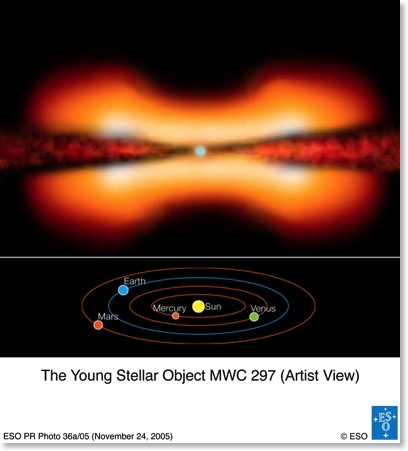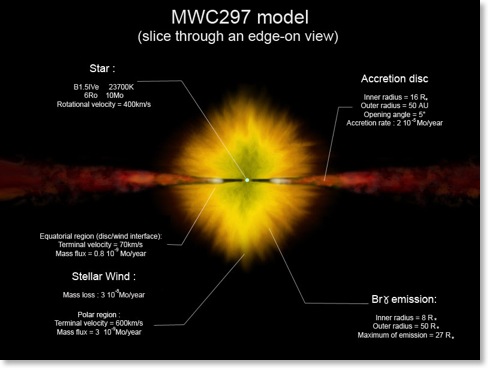The young stellar object MWC 297 is an embedded B1.5Ve star exhibiting strong hydrogen emission lines and a strong near-infrared continuum excess. This object has been observed with the VLT interferometer equipped with the AMBER instrument during its first commissioning run. VLTI/AMBER is currently the only near infrared interferometer that can observe spectrally dispersed visibilities. MWC 297 has been spatially resolved in the continuum with a visibility of 0.50+0.08 −0.10 as well as in the Brγ emission line where the visibility decreases to 0.33 ± 0.06. This change in the visibility with wavelength can be interpreted by the presence of an optically thick disk responsible for the visibility in the continuum and of a stellar wind traced by the Brγ emission line and whose apparent size is 40% larger. We validate this interpretation by building a model of the stellar environment that combines a geometrically thin, optically thick accretion disk model consisting of gas and dust, and a latitude-dependent stellar wind outflowing above the disk surface. The continuum emission and visibilities obtained from this model are fully consistent with the interferometric AMBER data. They agree also with existing optical, near-infrared spectra and other broad-band near-infrared interferometric visibilities. We also reproduce the shape of the visibilities in the Brγ line as well as the profile of this line obtained at an higher spectral resolution with the VLT/ISAAC spectrograph, and those of the Hα and Hβ lines.
The disk and wind models yield a consistent inclination of the system of approximately 20° . A picture emerges in which MWC 297 is surrounded by an equatorial flat disk that is possibly still accreting and an outflowing wind that has a much higher velocity in the polar region than at the equator. The VLTI/AMBER unique capability of measuring spectral visibilities therefore allows us for the first time to compare the apparent geometry of a wind with the disk structure in a young stellar system. The paper was published in A&A, 464, 43.
The following image was partly coming from our simulations and can be found on the ESO press release HERE

An announcement was also made by the French "Institut National des Sciences de l'Univers" (INSU) an can be found HERE (in French, sorry).

This is another nice picture from Anthony Meilland: why trying to build models since we already have nice pictures !